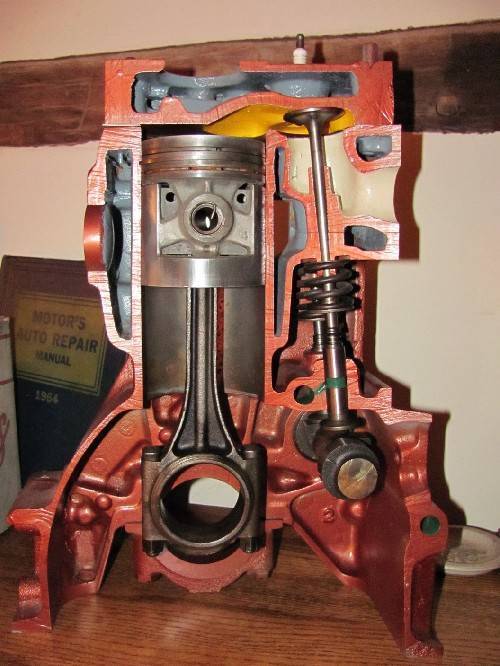|
Re: Big bore
|
||||
|---|---|---|---|---|
|
Home away from home

|
I could be wrong but I think the difference is in the stroke 4.25 on the 327 and 4.500 on the 359?
Posted on: 2013/5/12 16:32
|
|||
|
||||
|
Re: Big bore
|
||||
|---|---|---|---|---|
|
Home away from home
|
The 359 also had larger intake valves. It was a different casting.
One of the chief problems of a massive overbore on one of these blocks is that you'd end up with very little holding the top and the bottom of the engine together. Notice on the left below the waterjacket that there is only the cylinder wall itself connecting the crankcase to what is above.
Posted on: 2013/5/12 20:35
|
|||
|
||||
|
Re: Big bore
|
||||
|---|---|---|---|---|
|
Home away from home

|
That is a really cool cutaway. Is that something you own? It would seem that the L8 is pretty thin everywhere the port is also very close to the water so any major porting would be difficult. What are the valve sizes on the 359?
Posted on: 2013/5/12 23:26
|
|||
|
||||
|
Re: Big bore
|
||||
|---|---|---|---|---|
|
Home away from home
|
Did that one afternoon with a Sawzall on a cracked block.
Cylinder walls are 1/4". That thin part of the intake port is a hair over 1/8". I always clean up the ports but make no effort to enlarge them! If you look to left of the intake valve you can see why relieving is a good idea on any flathead that has the valves canted toward the cylinders.
Posted on: 2013/5/13 6:37
|
|||
|
||||
|
Re: Big bore
|
||||
|---|---|---|---|---|
|
Home away from home

|
Without a doubt Ross wins the "coolest thing on your desk" award.
With .250 thick cylinders you could probably get away with a .125 overbore but with core shift, rust ect that would be kinda scary, even with sonic testing. I had no idea that the water was so close to everything in these. Going from weight alone I would have thought they were very thick everywhere.
Posted on: 2013/5/13 6:53
|
|||
|
||||
|
Re: Big bore
|
||||
|---|---|---|---|---|
|
Home away from home

|
I know this is a bit off topic but that cut away also shows how little material would be left after machining for valve seat inserts and with internal corrosion there would be even less. As I have posted before, I had a cylinder block with valve seat inserts that cracked between the inserts. I attribute the cracking entirely to the weakening caused by the machining.
Posted on: 2013/5/13 7:03
|
|||
|
||||
|
Re: Big bore
|
||||
|---|---|---|---|---|
|
Home away from home

|
I don't claim to be a "profesional" nor "expert" engine builder (note use of quotation marks). But over my 40 years of amatuer engine building I will proclaim that in 95% of ANY engine rebuilding procedures of ANY engine made by ANY mfg'er at ANY time it is wise to avoid machining processes that are either unnecessary or done simply for "insurance".
Sometimes machining is necessary for conspicuous wear or damage of course. For mild street performance engines usually cam, carb and exhust changes are the best options. For those trying to build engines to win 24 hours of LeMans is a different story. SO different in fact that they probably have an infinite supply of parts. SIGNIFICANT Compression ratio is best achieved by increasing the stroke, this is especialy true on flat head engines. But stroking is a rather costly machining process. Cylinder boring for oversize pistons (when needed) is more of a machinig process to restore an engine. Compression and HP increase is not significant with boring. Building an engine to resemble a factory racing team car???? Go ahead. I'm glad for anyone that has factory resources for parts and machining at their beconded command.
Posted on: 2013/5/13 8:53
|
|||
|
VAPOR LOCK demystified: See paragraph SEVEN of PMCC documentaion as listed in post #11 of the following thread:f
https://packardinfo.com/xoops/html/modules/newbb/viewtopic.php?topic_id=7245 |
||||
|
||||
|
Re: Big bore
|
||||
|---|---|---|---|---|
|
Forum Ambassador

|
Also notice in Ross' very nice cutaway the minimal clearance between the open valve and the top of the combustion chamber - hence the oft-repeated warning to NOT surface a cylinder head unless absolutely essential and without first making careful measurements to insure that sufficient clearance remains. Many an otherwise good cylinder head has become a boat anchor in this way.
Posted on: 2013/5/13 9:22
|
|||
|
||||
|
Re: Big bore
|
||||
|---|---|---|---|---|
|
Home away from home

|
As Owen noted on the valve to head clearance this is where an aluminum head comes in handy for the purposes of ease of machining and possible welding if need be. The interesting point is it seems from the picture that the thickness of the combustion chamber over the valve is thicker than the cylinder wall thickness.
A second note to this is machining a bit extra clearance above the valve though it will lover compression slightly will really help the flow potential of the engine.
Posted on: 2013/5/13 9:56
|
|||
|
||||

 (113.99 KB)
(113.99 KB)






